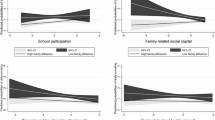Abstract
This exploratory study assessed the state-level association between social capital, poverty, and income inequality and adolescents' sexual risk and protective behaviors. A cross-sectional design using state-level correlations was employed. Seven outcome measures from the national 1999 Youth Risk Behavior Surveillance Survey were used. For females and males, social capital was significantly associated with five of the seven outcome measures (all associations p < 01). For females, the amount of variance explained by these correlations ranged from 23% to 45%; the range for males was 20% to 52%. Poverty was not a significant predictor of any outcome variable. Income inequality was a significant predictor of birth control usage among females, but in multivariate regression analyses, only social capital retained significance. Findings provide preliminary evidence that social capital may have a profound influence of adolescents' sexual risk and protective behaviors. Social capital was inversely correlated with sexual risk behaviors and positively correlated with protective sexual behaviors. Further and more comprehensive research involving social capital and adolescents is warranted.
Similar content being viewed by others
References
American Academy of Pediatrics: Committee on Adolescence. (1999). Adolescent pregnancy—Current trends and issues: 1998. Pediatrics, 103, 516–519.
Berkman, L. F., and Glass, T. (2000). Social integration, social networks, social support, and health. In L. F. Berkman and I. Kawachi (Eds.), Social epidemiology (pp. 137–173). New York: Oxford University Press.
Brown, S. S., and Eisenberg, L. (Eds.). (1995). The best intentions: Unintended pregnancy and the well-being of children and families. Washington, DC: National Academy Press.
Center on Budget and Policy Priorities/Economic Policy Institute. (2000). Pulling apart: A state-by-state analysis of income trends. Washington, DC: Author.
Centers for Disease Control and Prevention. (2000). Youth risk behavior surveillance—United States, 1999. MMWR, 49, 1–96.
Cohen, D., Spear, S., Scibner, R., Kissinger, P., Mason, K., and Wildgen, J. (2000). “Broken Windows” and the risk of gonorrhea. American Journal of Public Health, 90, 230–236.
Collier, P. (1998). Social capital and poverty (Social Capital Initiative Working Paper No. 4). Washington, DC: World Bank.
Crosby, R. A., and Miller, K. S. (2002). The pivotal role of the family on adolescent females' sexual health. In G. M. Wingood, and R. J. DiClemente (Eds.), Women's sexual and reproductive health: Social, psychological, and public health perspectives (pp. 113–128). New York, NY: Plenum/Kluwer Press.
Crosby, R. A., DiClemente, R. J., Wingood, G. M., Harrington, K., Davies, S. L., Hook, E. W., et al. (2002a). African American adolescent females' membership in community organizations is associated with STD/HIV-protective behaviors: A prospective analysis. Journal Epidemiology and Community Health, 23, 549–550.
Crosby, R. A., DiClemente, R. J., Wingood, G. M., Harrington, K., Davies, S. L., and Malow, R. (2002b). African American adolescent females' membership in social organizations is associated with protective behavior against HIV infection. Ethnicity and Disease, 12, 186–189.
Department of Health and Human Services. (2000). Healthy people 2010. Available online at www.health.gov/healthypeople. Accessed 30 December 2001.
DiClemente, R. J., and Crosby, R. A. (2003). Sexually transmitted diseases among adolescents: Risk factors, antecedents, and prevention strategies. In G. R. Adams and M. Berzonsky (Eds.), The Blackwell handbook of adolescence (pp. 573–605). Oxford: Blackwell.
Eng, T. R., and Butler, W. T. (1997). The hidden epidemic: Confronting sexually transmitted diseases. Washington, DC: National Academy Press.
Fullilove, R. E., and Fullilove, M. T. (2000). The family to family program: A structural intervention with implications for the prevention of HIV/AIDS and other community epidemics. AIDS, 14(Supplement), S63-S67.
Holtgrave, D. R., and Crosby, R. A. (2003). Social capital, poverty, and income inequality as predictors of gonorrhea, syphilis, chlamydia and AIDS case rates in the United States. Sexually Transmitted Infections, 79, 62–64.
Kawachi, I., and Berkman, L. (2000). Social cohesion, social capital and health. In L. F. Berkman and I. Kawachi (Eds.), Social epidemiology (pp. 174–190). New York: Oxford University Press.
Kawachi, I., Kennedy, B., Lochner, K., and Prothrow-Stith, D. (1997). Social capital, income inequality, and mortality. American Journal of Public Health, 87, 1491–1498.
Kawachi, I., Kennedy, B., and Glass, R. (1999). Social capital and self-rated health: A contextual analysis. American Journal of Public Health, 89, 1187–1193.
Kreuter, M. W., and Lezin, N. A. (2002). Social capital theory: Implications for community-based health promotion. In R. J. DiClemente, R. A. Crosby, and M. C. Kegler (Eds.), Emerging theories in health promotion practice and research (pp. 228–254). San Francisco, CA: Jossey-Bass/Wiley.
Putnam, R. D. (2000). Bowling alone: The collapse and revival of American community. New York: Touchstone.
Putnam, R. D. (2001). Comprehensive Social Capital Index. Available online at www.bowlingalone.com, Accessed 17 October 2001.
Ramirez-Valles, J., Zimmerman, M. A., and Newcomb, M. D. (1998). Sexual risk behavior among youth: Modeling the influence of prosocial activities and socioeconomic factors. Journal of Health and Social Behavior, 39, 237–253.
Runyan, D. K., Hunter, W. M., and Socolar, R. R. S. (1998). Children who prosper in unfavorable environments: The relationship to social capital. Pediatrics, 101, 12–18.
Santelli, J. S., DiClemente, R. J., Miller, K. S., and Kirby, D. (1999). Sexually transmitted diseases, unintended pregnancy, and adolescent health promotion. Adolescent Medicine State of the Art Reviews, 10, 87–108.
Schinke, S. P., Orlandi, M. A., and Cole, K. C. (1992). Boys and girls clubs in public housing developments: Prevention services for youth at risk. Journal of Community Psychology, 28, 118–128.
Substance Abuse and Mental Health Services Administration. (2001). State profiles, 2000, On public sector managed behavioral health care [DHHS Publication No. (SMA) 00–3432]. Washington, DC: U.S. Department of Health and Human Services.
U.S. Census Bureau (2001). Poverty 1998. Available online at www.census.gov/hhes/poverty/poverty98/pv98state.html. Accessed 26 October 2001.
Author information
Authors and Affiliations
Corresponding author
Rights and permissions
About this article
Cite this article
Crosby, R.A., Holtgrave, D.R., DiClemente, R.J. et al. Social Capital as a Predictor of Adolescents' Sexual Risk Behavior: A State-Level Exploratory Study. AIDS Behav 7, 245–252 (2003). https://doi.org/10.1023/A:1025439618581
Issue Date:
DOI: https://doi.org/10.1023/A:1025439618581




